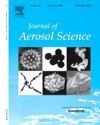Indoor air sampling for detection of viral nucleic acids
IF 2.9
3区 环境科学与生态学
Q2 ENGINEERING, CHEMICAL
引用次数: 0
Abstract
Detecting and monitoring airborne viruses is critical for mitigating the spread of infectious diseases and safeguarding public health. Indoor air sampling has emerged as a promising but underexplored approach to the surveillance of viral pathogens, complementing more established methods such as clinical diagnostics and wastewater-based epidemiology. Indoor air contains viral particles originating from human occupants through exhaled respiratory droplets, skin shedding, and resuspension of contaminated dust, making it a valuable target for viral biosurveillance. Although viruses typically account for less than 1% of total sequences in metagenomic data from air samples, a wide range of human-infecting viruses, including respiratory and skin-associated pathogens, can be detected using various capture mechanisms. This review provides a comprehensive examination of indoor air sampling for viral nucleic acid detection, focusing on the sources and composition of viruses indoors; sampling technologies; and strategies for effective implementation. We examine three complementary approaches to viral collection: active air sampling using dedicated collection devices; passive sampling primarily through settled dust analysis; and monitoring of building heating, ventilation, and air conditioning (HVAC) systems. For active sampling, we assess previously published results on the efficacy of filtration, impaction, impingement, cyclonic separation, electrostatic precipitation, and condensation for viral collection, highlighting challenges in optimizing sampling efficiency for submicrometer particles and recovering sufficient viral nucleic acids for analysis. For passive and HVAC-based approaches, we evaluate their potential for providing temporally-integrated, building-wide viral surveillance data while requiring minimal additional infrastructure. We examine potential strategies for implementing these approaches, particularly in airports and healthcare facilities. Future studies should focus on addressing such knowledge gaps, optimizing sampling methodologies, and developing best practices for integrating air sampling into public health surveillance systems.

室内空气采样检测病毒核酸
检测和监测空气传播的病毒对于减轻传染病的传播和保障公众健康至关重要。室内空气采样已成为一种有前途但尚未得到充分探索的病毒性病原体监测方法,可作为临床诊断和基于废水的流行病学等更成熟方法的补充。室内空气中含有来自人体的病毒颗粒,通过呼出的呼吸道飞沫、皮肤脱落和污染灰尘的再悬浮,使其成为病毒生物监测的重要目标。虽然病毒通常只占空气样本宏基因组数据中总序列的不到1%,但使用各种捕获机制可以检测到广泛的人类感染病毒,包括呼吸道和皮肤相关病原体。本文综述了室内空气采样技术在病毒核酸检测中的应用,重点介绍了室内病毒的来源和组成;抽样技术;以及有效实施的战略。我们研究了三种互补的病毒收集方法:使用专用收集设备进行主动空气采样;被动取样主要通过尘埃分析;以及对建筑供暖、通风和空调(HVAC)系统的监控。对于主动采样,我们评估了先前发表的过滤、撞击、撞击、旋风分离、静电沉淀和冷凝对病毒收集的效果,强调了优化亚微米颗粒采样效率和回收足够的病毒核酸用于分析的挑战。对于被动式和基于暖通空调的方法,我们评估了它们在提供临时集成的、建筑范围的病毒监测数据的潜力,同时需要最少的额外基础设施。我们研究了实施这些方法的潜在战略,特别是在机场和医疗机构。未来的研究应侧重于解决这些知识差距,优化采样方法,并制定将空气采样纳入公共卫生监测系统的最佳做法。
本文章由计算机程序翻译,如有差异,请以英文原文为准。
求助全文
约1分钟内获得全文
求助全文
来源期刊

Journal of Aerosol Science
环境科学-工程:化工
CiteScore
8.80
自引率
8.90%
发文量
127
审稿时长
35 days
期刊介绍:
Founded in 1970, the Journal of Aerosol Science considers itself the prime vehicle for the publication of original work as well as reviews related to fundamental and applied aerosol research, as well as aerosol instrumentation. Its content is directed at scientists working in engineering disciplines, as well as physics, chemistry, and environmental sciences.
The editors welcome submissions of papers describing recent experimental, numerical, and theoretical research related to the following topics:
1. Fundamental Aerosol Science.
2. Applied Aerosol Science.
3. Instrumentation & Measurement Methods.
 求助内容:
求助内容: 应助结果提醒方式:
应助结果提醒方式:


